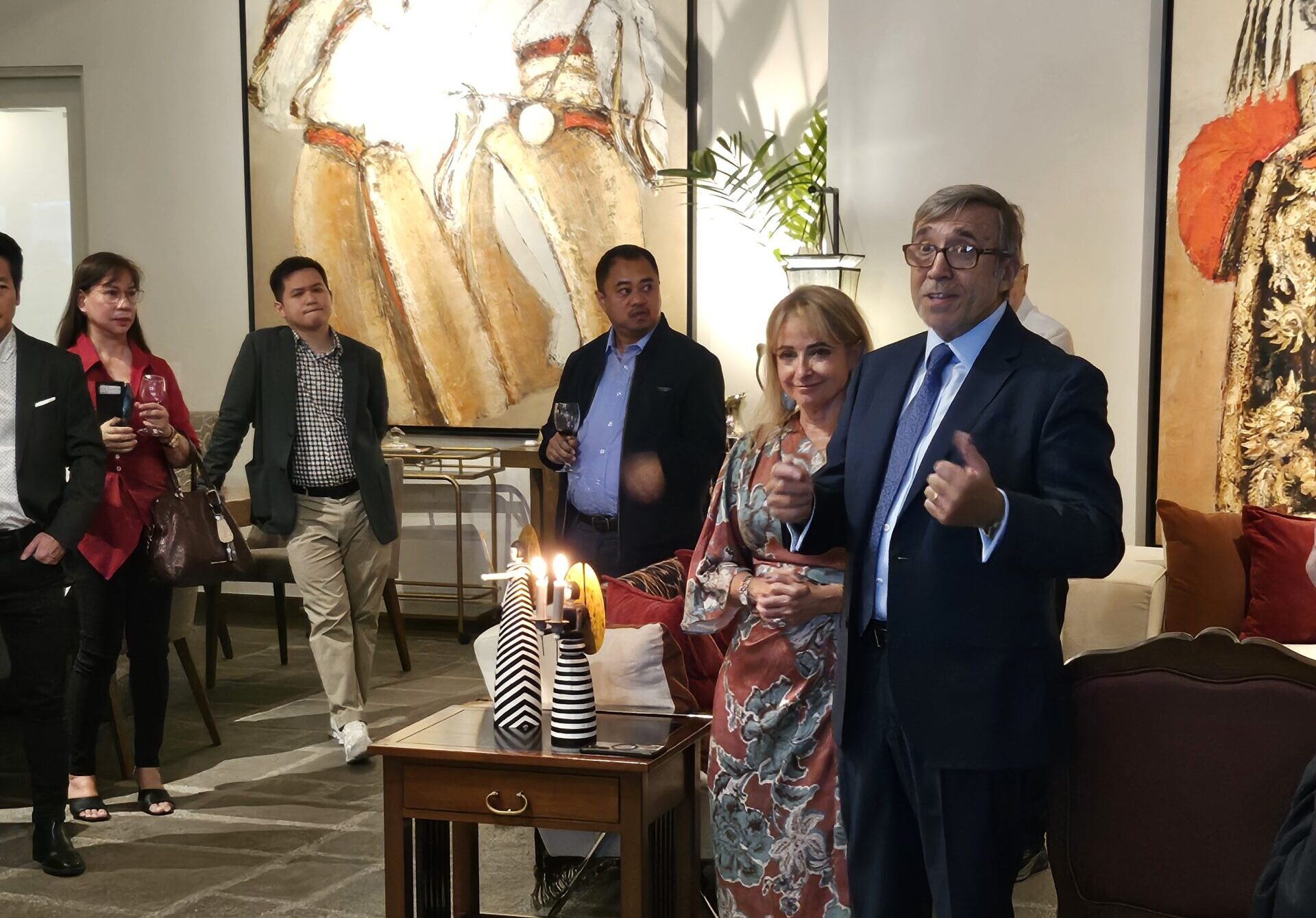Editor’s note: The nation is marking this February the 57th anniversary of the Liberation of Manila. Historian Benito Legarda, former deputy governor for research of the Central Bank of the Philippines, relates a survivor’s account of the horrors of the event, particularly the massacre of nuns of St. Paul’s College and other civilians in Malate and Ermita by the retreating Japanese.
Today is Friday, Feb. 3, 2012—a Day of Remembrance. Flashback to Feb. 3, 1945—a day that brings to mind the stark events of a war that begs not to be forgotten.
So begins a vivid account of the ordeal undergone by the family of Ofelia “Ofie” Villonco Viola, daughter of Dr. Teofifo Villonco.
Fateful Saturday, Feb. 3
At 8 p.m. that February day, Dr. Villonco received a phone call in code: “The white leghorns have arrived! Listen to the shooting going on.” The Americans were in Manila.
Dr. Villonco calmly ordered everyone to pack up. They still heard Mass at Malate Church on Sunday, Feb. 4, but by Tuesday, American shells were landing on targets beyond the church. After breaking down portions of the walls of the intervening properties, they transferred to the fourth floor of the Sinagoga Apartments owned by the De Leon family.
On Wednesday the 7th, Dr. Villonco stored his prized artworks in the air-raid shelter in his garden. (The Amorsolos were later looted, but the heavy alabaster statues remained.) Food, canned goods, cooking utensils, China and bedsheets were taken to the apartment.
On the 8th, there were rumors of the Japanese hurling Molotov cocktails at their neighbors’ homes. The following day, Dr. Conrado Potenciano’s house went up in flames, along with two or more other houses.
“Our neighbors begin to arrive in trickles—the Montinolas, the Hilarios, the Manerus, and other refugees…,” writes Ofie.
The apartment building’s ground floor became a mini-clinic where the injured were attended to by three doctors (Potenciano, Villonco, Ireneo Carlos and medical student Titong Potenciano).
St. Paul Massacre
In the afternoon, young Tony Carlos arrived after escaping the massacre at St. Paul’s College.
The nuns and refugees had been told to go to the auditorium, whose doors were then locked. The Japanese threw grenades at the victims from a hole in the ceiling, setting off pandemonium. Tony caught a grenade and hurled it against the wall, blowing open a small gap through which he escaped.
A pet goat was quartered for food on the 10th and distributed to neighbors and refugees. The fires drew closer from two sides.
Death of Mrs. Rocha
The artillery duel between the Japanese in Plaza Militar and Malate Church and the Americans intensified. American shells were falling closer, and, that night, hit the bungalow of Antonio Rocha.
Mrs. Rocha was brought in on a makeshift stretcher. When her injuries were examined, Dr. Villonco “almost faints from the utter devastation of her lower extremities.” Titong Potenciano administered morphine but she died an hour later.
Polite but firm: You will be burned
On the morning of Sunday, Feb. 11, writes Ofie, “a Japanese soldier, strangely polite but otherwise determined, has come to say the apartment is going to be burned.”
Dr. Villonco ordered his family “to gulp down whatever fresh food there was in the kitchen,” then pack the most essential things: canned goods, a half sack of rice, medicines, and Ofie’s swimming cape for protection against the night chill.
Moving out
On Monday morning, Feb. 12, the refugees assembled on the ground floor, recited the Rosary, following the calm and firm Jorge de Leon as he recited the Credo.
The ragtag group was an incongruous sight. Most clutched “holy pictures and statues of the Sacred Heart and Blessed Virgin.” Knapsacks, emergency kits, small bags, and cushions were strapped on shoulders and heads. The wife of Dr. Carlos carried a carefully covered bird cage. (This survived the ordeal.) Some wore multiple layers of dresses. All eyes mutely mirrored fright and helplessness.
When fire reached a house two doors away, they went through the open gardens to the farthest still-unburned house. There Doña Luisa Lichauco gave them homemade sweets of condol and watermelon rinds. Ofie’s companion, Lulie Potenciano, found a can of Milo in her small bag, which they hoarded.
In the garden with them were members of the De Leon clan: “…teenagers Peping, Badoding, Benny, Oscar, and their younger sister Trining, Lydia and Bernadette…”
From the garden they watched two men pushing a cart piled high with goods hit a land mine and get blown to smithereens. Later, this would explain why there were dead bodies and burned body parts hanging grotesquely from tree branches. Looters, mostly.
Finally, someone called out that it was her house burning. “I feel a sinking sensation in my stomach and tears begin to flow.”
Crossing A. Mabini
But there was no time for sentimentality.
They crossed A. Mabini Street, found four sturdy walls among the charred ruins, and each family among the approximately 60 refugees staked out its own space, erecting roofs with burned G.I. sheets.
For food, they opened a can of cocktail sausages and nilugaw. They lay on the sooty cement through the long night, hearing the sounds of battle—gasoline explosions, rolling tanks, machine guns, rifle fire—and also those of injury and death, low and painful breathing. A De Leon Family housemaid named Milagring died there.
Worst day
On the morning of Tuesday, the 13th, they went to a well at the Realistic Beauty Salon to drink. But two dead bodies in the well made them forget their thirst. Tony Carlos told them he was going to a nearby well to wash his soot-blackened face.
Without warning, Japanese artillery barrages resumed, with American artillery responding. When the shelling abated, the wounded were brought in.
One of those dripping blood from a stretcher was Tony Carlos. Jorge de Leon and his sister Regina worked on him. Ofie joined the group. Tony asked for a rosary. They all tried to remove with their fingers the shrapnel from his arms and legs, while Jorge said the prayer for the dying.
Titong Potenciano said Tony had only a 30-percent chance of survival. “Let’s pray for that chance,” said the doctor. The prayer was answered. Ofie learned later that Tony had survived, with some shrapnel still embedded in his body.
An American spotter plane flew overhead and, mistaking the refugees’ encampment for Japanese, brought artillery shells crashing down. “So here we are, dirty, hungry, exhausted and cursing the Americans to high heavens!” writes Ofie.
Japanese confiscation
At 4:30 p.m., two Japanese soldiers appeared and ordered them to raise their hands. A sentry had been killed nearby. But what they did was to confiscate wristwatches from the unresisting refugees, who were ordered not to leave as they planned to return at 7 p.m. to look for concealed firearms. Even facing imminent death, greed dominated the Japanese.
Escape and deliverance
The elders decided that they had to leave at once, out into the eerie landscape of now unrecognizable streets with gruesome scenes.
“The dead and wounded are scattered everywhere, telling us plainly that the Japanese have violated every shred of human decency,” writes Ofie in fury and horror.
The group now numbered 40, not knowing exactly where they were going, treading the streets carefully to avoid mines. They saw five Japanese hoisting a machine gun to the rooftop of the Rosaria Apartments.
At a street corner near the Philippine Women’s University, two Filipinos wearing red armbands sternly told them to cross Taft Ave. and proceed to Paco Market. They might be pro-Japanese Makapilis luring them to a massacre, so she and two De Leon boys tried to run back. But her sister Nida was already across Taft Ave., and screamed for them to come over, which they did. Suddenly she realized, “we are safe!” Their happy cries and shrieks of delight were cut short by a stern American MP who ordered them to go to Paco Market.
At Paco bridge at 6:30 p.m., they were met by relieved and happy relatives. She saw a dead Japanese soldier with his body burning, looking grotesquely black and bloated but the flames producing all imaginable colors— blue and crimson, green, yellow, red and purple. When she had walked 10 meters past, the body exploded, from the grenade in its belt.
They spent the night at Settlement House where the group broke up. The following morning, Settlement House blew up from Japanese bombs planted underneath and her father decided to move on to Santa Ana.
There they found a cramped room. Their two pet dogs had been rescued and returned by friends, and one, a dachshund, was traded for five loaves of bread with an American colonel. Like all other refugees, they lined up for secondhand clothes, cans of sardines, medicines.
Head on the wall
In Santa Ana, surviving friends from the De La Salle College Massacre, Lulu Cojuangco and Diony Carlos, were reunited with them. They were frail and weak from multiple bayonet wounds.
While visiting them, a commotion erupted outside when Americans and Filipino guerrillas caught Japanese snipers. The Filipinos insisted that one prisoner be turned over to them.
When the Villonco girls went home at dusk, Ofie glimpsed an object atop the perimeter wall along the riverbank. It was the head of a Japanese, eyes closed, hair shaven, with an ashen-white face. They hurried home lest there be more snipers lurking in the area.
Lesson
Being a refugee taught Ofie what it meant to be poor. It could actually be “an ennobling experience…one is able to cross the divide that separates prince from pauper with equanimity and grace. Adversity is the ultimate lesson in flexibility and ultimately self-reliance. You become a survivor.”
Two years ago, she visited Japan with some family members. “We found our erstwhile foes to be gentle, extremely polite and quite charming. Wounds have healed, what is past has been forgiven, but it can never quite be forgotten.”
Yes, but the healed wounds have left ugly scars in our irreplaceable cultural heritage and our national psyche.














































